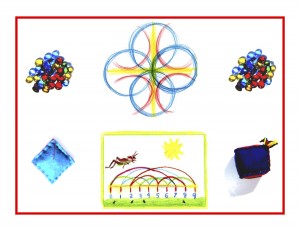Day 52
For one year, 365 days, this blog will address the Common Core Standards from the perspective of creating an alternate, ambient learning environment for math. Ambient is defined as “existing or present on all sides, an all-encompassing atmosphere.” And ambient music is defined as: “Quiet and relaxing with melodies that repeat many times.”
Why ambient? A math teaching style that’s whole and all encompassing, with themes that repeat many times through the years, is most likely to be effective and successful. Today’s post will focus on the form drawing block, which begins the Grade 1 year. The child(ren)’s willingness to take on the task of learning shines as the teacher or parent is recognized as the authority who can impart that knowledge and wisdom. Form drawing is an apt way to begin, with its emphasis on the deep recognition of geometry in its truest sense: as “geo” earth, “metry” measurement. The Common Core Math Standard will appear in blue, followed by its ambient counterpart.
Geometry 1.G
Reason with shapes and their attributes.
1. Distinguish between defining attributes (e.g., triangles are closed and three-sided) versus non-defining attributes (e.g., color, orientation, overall size); build and draw shapes to possess defining attributes.
The forms are introduced in a variety of ways, through story and movement. After an overall image is imparted through a simple story, the form is intuitively grasped with the teacher’s help, and then moved, running or walking, large on the floor, usually within the parameter of the large (at least 4 feet in diameter) circle. After the form is run on the floor, it’s drawn in the air with a crayon, and finally drawn on paper. In this way, distinctions can be made by the child(ren) between the sizes drawn on the floor with their feet, in the air, and on paper.
The first and most essential element learned in form drawing is the difference between the straight line and curve, and the realization that everything everywhere is made up of one or the other or both. The straight line and curve drawn together is the first form, then many variations of that follow, establishing the solid grounding and confident ability to know and master versions of the main element of all being, its form. Structured forms follow: the circle, square, triangle, hexagram, etc., many of them juxtaposed in relation to numbers. The circle is related to the number 1, the triangle to the number 4, the hexagon to the number 6, to name just a few. Shapes are built and drawn to possess their attributes most effectively, by using all the senses and movement to learn them.
After 3-4 weeks of being immersed in the forms that make up universal structure, the child(ren) proceed with confidence on a first venture into learning. Form drawing can be brought back every Monday to reinforce this grounding and orientation as a means of centering and focusing on the current subject.
True knowledge ensues in an environment dedicated to imaginative, creative knowing, where student and teacher alike surrender to the ensuing of that knowledge as a worthy goal. Tune in tomorrow for more Grade 1 form drawing and geometry!












